Themed collection World Cancer Day 2024: Showcasing cancer research across the RSC

Polyprodrugs for tumor chemotherapy: from molecular structure to drug release performance
The structure–property relationship of polyprodrugs was explored from the perspective of molecular structure, by discussing the effects of the conjugations and linkers on their drug content and drug releasing performance.

J. Mater. Chem. B, 2023,11, 9565-9571
https://doi.org/10.1039/D3TB01700A
Perspective of point-of-care sensing systems in cancer management
Revolutionizing cancer management: point-of-care sensing systems in perspective.

Mater. Adv., 2023,4, 4991-5002
https://doi.org/10.1039/D3MA00525A
Sonocatalytic cancer therapy: theories, advanced catalysts and system design
Sonocatalytic cancer therapy has emerged as a promising strategy through the combination of ultrasound waves and catalytic materials to selectively target and destroy cancer cells.

Nanoscale, 2023,15, 19407-19422
https://doi.org/10.1039/D3NR04505F
Prospects of nanoparticle-based radioenhancement for radiotherapy
Inorganic nanomaterials show promising potential for radiotherapy enhancement. This article provides a concise summary of mechanisms involved, materials designs and future prospects of nanoparticle-based radioenhancement for precision medicine.

Mater. Horiz., 2023,10, 4059-4082
https://doi.org/10.1039/D3MH00265A
Injectable hydrogels for the delivery of nanomaterials for cancer combinatorial photothermal therapy
Injectable hydrogels intended for cancer combinatorial-photothermal therapy bring forward the possibility of attaining multifunctional systems for an improved and selective treatment for this disease.

Biomater. Sci., 2023,11, 6082-6108
https://doi.org/10.1039/D3BM00845B
3D bioprinting complex models of cancer
Cancer is characterized by the uncontrolled division of cells, resulting in the formation of tumors. The personalized composition of biomaterials and 3D techniques can be used as a modelling tool to understand the complexity of various cancers.

Biomater. Sci., 2023,11, 3414-3430
https://doi.org/10.1039/D2BM02060B
Graphene family in cancer therapy: recent progress in cancer gene/drug delivery applications
In the past few years, the development in the construction and architecture of graphene based nanocomplexes has dramatically accelerated the use of nano-graphene for therapeutic and diagnostic purposes, fostering a new area of nano-cancer therapy.

J. Mater. Chem. B, 2023,11, 2568-2613
https://doi.org/10.1039/D2TB01858F
Recent advances in PAMAM dendrimer-based CT contrast agents for molecular imaging and theranostics of cancer
Recent advances and some key developments in the construction of PAMAM dendrimer-based nanoplatforms for tumor CT imaging and theranostics have been reviewed.

Sens. Diagn., 2023,2, 1145-1157
https://doi.org/10.1039/D3SD00101F
Diagnosis of cancer using carbon nanomaterial-based biosensors
Basic principle of sensing technique of various carbon nanomaterial-based biosensors.

Sens. Diagn., 2023,2, 268-289
https://doi.org/10.1039/D2SD00182A
Re-engineered theranostic gold nanoparticles for targeting tumor hypoxia
Developing nanovehicles for selective delivery of a radiation dose/drug to hypoxic tumors is a present-day clinical requirement for effective treatment of cancer.

Mater. Adv., 2024,5, 513-520
https://doi.org/10.1039/D3MA00679D
Self-reported and self-facilitated theranostic oxygen nano-economizer for precise and hypoxia alleviation-potentiated photodynamic therapy
A self-reported and self-facilitated theranostic oxygen nano-economizer (PTTD NPs) for precise photodynamic therapy (PDT) is developed. Under self-reported optimal laser duration, PTTD NPs could alleviate tumor hypoxia for self-facilitating PDT.

Mater. Horiz., 2023,10, 5734-5752
https://doi.org/10.1039/D3MH01244A
A biocompatible pure organic porous nanocage for enhanced photodynamic therapy
A biocompatible porphyrin-based pure organic porous nanocage with large cavity, high porosity as well as enhanced type I and type II reactive oxygen species generation is developed for photodynamic therapy.

Mater. Horiz., 2023,10, 4868-4881
https://doi.org/10.1039/D3MH01263H
Cell membrane-specific self-assembly of peptide nanomedicine induces tumor immunogenic death to enhance cancer therapy
A strategy of cell membrane-specific self-assembly based on peptide nanomedicine is developed to induce tumor immunogenic death in cancer therapy.

Nanoscale Horiz., 2023,8, 1226-1234
https://doi.org/10.1039/D3NH00173C
Tumor-microenvironment-responsive poly-prodrug encapsulated semiconducting polymer nanosystem for phototherapy-boosted chemotherapy
Phototherapy-induced hypoxia boosts the chem-therapy of PEG-TPZ for enhanced theranostics.

Mater. Horiz., 2023,10, 3014-3023
https://doi.org/10.1039/D3MH00242J
HER-2-targeted boron neutron capture therapy using an antibody-conjugated boron nitride nanotube/β-1,3-glucan complex
HER-2 targeted boron nitride nanotube was developed as a boron agent for boron neutron capture therapy.

Nanoscale Adv., 2023,5, 3857-3861
https://doi.org/10.1039/D3NA00028A
Ultrafast sensitivity-controlled and specific detection of extracellular vesicles using optical force with antibody-modified microparticles in a microflow system
We propose a detection method of 103–104 nanoscale extracellular vesicles secreted from cancer cells and distinguish their multiple membrane proteins using controlled optical force and microfluidic pressure only by 5 minutes laser irradiation.
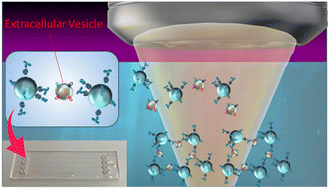
Nanoscale Horiz., 2023,8, 1034-1042
https://doi.org/10.1039/D2NH00576J
Rapid identification of molecular subtyping of breast cancer cell lines using a multi-channel sensor array
A multi-channel sensor array composed of three fluorescent units is constructed to differentiate and identify molecular subtypes of breast cancer.

Sens. Diagn., 2023,2, 837-841
https://doi.org/10.1039/D3SD00094J
Carbonic anhydrase IX-targeted nanovesicles potentiated ferroptosis by remodeling the intracellular environment for synergetic cancer therapy
This work demonstrated a nanovesicle-potentiated ferroptosis by remodeling the tumor intracellular environment, providing a promising paradigm for designing nanomedicines to heighten ferroptosis-based synergetic therapeutics.

Nanoscale Horiz., 2023,8, 783-793
https://doi.org/10.1039/D2NH00494A
Plasma extracellular vesicle phenotyping for the differentiation of early-stage lung cancer and benign lung diseases
A nanostrategy that combines bright core–shell probes, a nanomixing chip, and machine learning was proposed to evaluate the clinical performance of plasma EV phenotypes in differentiating early-stage lung cancer and benign lung diseases.

Nanoscale Horiz., 2023,8, 746-758
https://doi.org/10.1039/D2NH00570K
Discrimination between protein glycoforms using lectin-functionalised gold nanoparticles as signal enhancers
Biolayer interferometry is used to distinguish between glycoforms of the same using lectin-functional nanoparticles as both readers, and signal enhancers. The use of this is exemplified with prostate specific antigen.
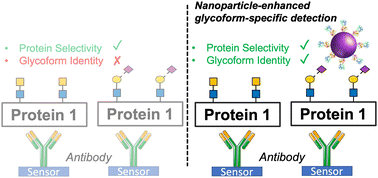
Nanoscale Horiz., 2023,8, 377-382
https://doi.org/10.1039/D2NH00470D
Cationic dextrin nanoparticles for effective intracellular delivery of cytochrome C in cancer therapy
Intracellular protein delivery using cationic dextrin nanoparticles show promise as a selective and specific approach to cancer therapy.

RSC Chem. Biol., 2024,5, 249-261
https://doi.org/10.1039/D3CB00090G
AGuIX nanoparticle-nanobody bioconjugates to target immune checkpoint receptors
Comparison of click chemistry and sortagging grafting strategies for functionalizing AGuIX nanoparticles with nanobodies to develop a tri-functional technology combining MRI imaging, radiotherapy, and immunotherapy by inhibiting immune checkpoints.

Nanoscale, 2024,16, 2347-2360
https://doi.org/10.1039/D3NR04777F
Targeted photodynamic therapy for breast cancer: the potential of glyconanoparticles
Glyconanoparticles selectively bind to cellular targets via glycan–lectin interactions and are excellent drug-delivery systems for targeted photodynamic therapy of cancer.

Nanoscale Adv., 2023,5, 6501-6513
https://doi.org/10.1039/D3NA00544E
Ultra-small platinum-based coordination nanoparticles for radiotherapy
Two novel nanoparticles based on Pt-containing coordination networks, produced by a green method, reveal important radioenhancement activity on cancerous cells.

Mater. Adv., 2023,4, 5314-5323
https://doi.org/10.1039/D3MA00516J
Bismuth nanoclusters on nitrogen-doped porous carbon nanoenzyme for cancer therapy
We have designed a highly efficient bismuth nanocluster supported on nitrogen-doped porous carbon as a nanozyme (Bi-NC) for cancer therapy. At the same time, Bi-NC shows good photothermal conversion performance to generate heat for strengthening the therapy.

Nanoscale, 2023,15, 16619-16625
https://doi.org/10.1039/D3NR03957A
Functionalized manganese iron oxide nanoparticles: a dual potential magneto-chemotherapeutic cargo in a 3D breast cancer model
Dual magneto-chemotherapeutic effects on a 3D breast cancer model after 10, 20 and 30 min of treatment.

Nanoscale, 2023,15, 15686-15699
https://doi.org/10.1039/D3NR02816J
Thymoquinone-loaded lipid nanocapsules with promising anticancer activity for colorectal cancer
Lipid nanocapsules was used as thymoquinone nano delivery system to treat colorectal cancer (CRC). TQ-LNCs show a suitable mean size particle and a high drug payload, inducing an early decrease in tumor growth following intratumoral administration to mice.

Nanoscale Adv., 2023,5, 5390-5398
https://doi.org/10.1039/D3NA00445G
Biodegradable covalent organic frameworks achieving tumor micro-environment responsive drug release and antitumor treatment
A biodegradable COF was constructed to break in response to tumors, enhancing the therapeutic effect on tumors.

Biomater. Sci., 2023,11, 6524-6536
https://doi.org/10.1039/D3BM01088K
Photophysical and biological assessment of coumarin-6 loaded polymeric nanoparticles as a cancer imaging agent
Coumarin-6 is used as a model hydrophobic drug to investigate delivery to tumors via polymeric micelles. Photophysical characterization, as well as in vitro and in vivo experiments showcase this platform for cancer diagnosis and imaging.

Sens. Diagn., 2023,2, 1277-1285
https://doi.org/10.1039/D3SD00065F
In vivo targeting of a tumor-antigen encoded DNA vaccine to dendritic cells in combination with tumor-selective chemotherapy eradicates established mouse melanoma
Eradicating established mouse melanoma by tumor-selective chemotherapy in combination with in vivo dendritic cell targeted genetic immunization using a tumor antigen encoded DNA vaccine.
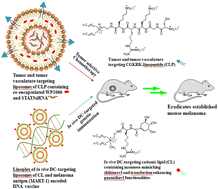
Biomater. Sci., 2023,11, 6135-6148
https://doi.org/10.1039/D3BM00702B
A mitochondria-targeted chemiluminescent probe for detection of hydrogen sulfide in cancer cells, human serum and in vivo
Mitochondria-targeted chemiluminescent probe MCH enables visualization of hydrogen sulfide activity in cancer cells, human serum, and animal models.

RSC Chem. Biol., 2023,4, 675-684
https://doi.org/10.1039/D3CB00070B
An anti-glioblastoma gold(I)–NHC complex distorts mitochondrial morphology and bioenergetics to induce tumor growth inhibition
A new gold(I)-based therapeutic strategy to treat glioblastoma multiforme (GBM).

RSC Chem. Biol., 2023,4, 592-599
https://doi.org/10.1039/D3CB00051F
Structural and molecular insight into antibody recognition of dynamic neoepitopes in membrane tethered MUC1 of pancreatic cancer cells and secreted exosomes
We unveil for the first time that pancreatic cancer cells (PANC-1) and secreted exosomes express MUC1 bearing cancer-relevant dynamic epitopes recognized specifically by an anti-MUC1 antibody (SN-131).

RSC Chem. Biol., 2023,4, 564-572
https://doi.org/10.1039/D3CB00036B
Construction of Fe-doped ZIF-8/DOX nanocomposites for ferroptosis strategy in the treatment of breast cancer
The DOX@7FZ was able to enhance the ROS level in cancer cells via a synergistic effect between apoptosis/ferroptosis synergism.
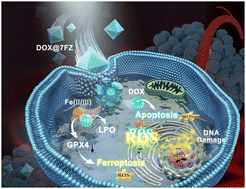
J. Mater. Chem. B, 2023,11, 6335-6345
https://doi.org/10.1039/D3TB00749A
Redox double-switch cancer theranostics through Pt(IV) functionalised manganese dioxide nanostructures
A new redox-responsive double-switch cancer theranostic was developed based on Mn nanostructures and a Pt prodrug. The ability of these probes to respond to altered redox states was validated in 2/3D cell models and in a preclinical mouse model.

Nanoscale, 2023,15, 10763-10775
https://doi.org/10.1039/D3NR00076A
Evaluating glioblastoma tumour sphere growth and migration in interaction with astrocytes using 3D collagen-hyaluronic acid hydrogels
Glioblastoma cells co-cultured with astrocytes in col-HA hydrogels exhibit changes in migration patterns. 3D in vitro models using ECM mimetic materials can be used to analyze glioma-astrocyte crosstalk.

J. Mater. Chem. B, 2023,11, 5442-5459
https://doi.org/10.1039/D3TB00066D
Erythrocyte membrane-camouflaged DNA-functionalized upconversion nanoparticles for tumor-targeted chemotherapy and immunotherapy
We report the new biomimetic nanoparticles, which is the synergistic combination of immunogenic cell death inducer and immunoadjuvant, proving to be the unique strategy to successfully induce an immune response and boost the anticancer response.

Nanoscale, 2023,15, 9457-9476
https://doi.org/10.1039/D3NR00542A
Polypropylene sulphide coating on magnetic nanoparticles as a novel platform for excellent biocompatible, stimuli-responsive smart magnetic nanocarriers for cancer therapeutics
Magnetic nanoparticle delivery systems are promising for targeted drug delivery, imaging, and chemo-hyperthermia of cancer; but their toxicity from reactive oxygen species generation, targeted delivery, and biodegradation limits their use.

Nanoscale, 2023,15, 7384-7402
https://doi.org/10.1039/D2NR05218K
Iron nitroprusside as a chemodynamic agent and inducer of ferroptosis for ovarian cancer therapy
A schematic representation of FeNP-induced ROS production and its involvement in ferroptosis.
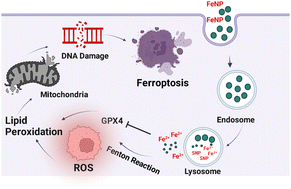
J. Mater. Chem. B, 2023,11, 3124-3135
https://doi.org/10.1039/D2TB02691K
Tumor-targeted molybdenum disulfide@barium titanate core–shell nanomedicine for dual photothermal and chemotherapy of triple-negative breast cancer cells
Intracellular working mechanism of Gem-loaded MBPF CSNPs when exposed to NIR laser irradiation. MBPF passively targets and enhances ROS generation and DNA damage within MDA-MB-231 cells through their dual performance.

J. Mater. Chem. B, 2023,11, 1044-1056
https://doi.org/10.1039/D2TB02382B
Zn doped iron oxide nanoparticles with high magnetization and photothermal efficiency for cancer treatment
The substitution of Fe2+ ions by Zn2+ ions in the crystal lattice of ferrites increases both the nanoparticles magnetization, and their photothermal conversion efficiency.

J. Mater. Chem. B, 2023,11, 787-801
https://doi.org/10.1039/D2TB01338J
Newly synthesized 6-substituted piperazine/phenyl-9-cyclopentyl containing purine nucleobase analogs act as potent anticancer agents and induce apoptosis via inhibiting Src in hepatocellular carcinoma cells
When the purine analog, compound 19, is introduced to liver cancer cells, selectively interacting with ALK and BTK, phospho-Src, phospho-Rb, cyclin E, and cdk2 levels decrease, thereby leading the cell to apoptosis.

RSC Med. Chem., 2023,14, 2658-2676
https://doi.org/10.1039/D3MD00440F
Novel pyrazolo[3,4-d]pyrimidine derivatives: design, synthesis, anticancer evaluation, VEGFR-2 inhibition, and antiangiogenic activity
A novel series of 12 pyrazolo[3,4-d]pyrimidine derivatives were created and evaluated in vitro for their antiproliferative activity against the NCI 60 human tumor cell line panel.
![Graphical abstract: Novel pyrazolo[3,4-d]pyrimidine derivatives: design, synthesis, anticancer evaluation, VEGFR-2 inhibition, and antiangiogenic activity](/en/Image/Get?imageInfo.ImageType=GA&imageInfo.ImageIdentifier.ManuscriptID=D3MD00476G&imageInfo.ImageIdentifier.Year=2023)
RSC Med. Chem., 2023,14, 2640-2657
https://doi.org/10.1039/D3MD00476G
Discovery of pyrazolopyrimidines that selectively inhibit CSF-1R kinase by iterative design, synthesis and screening against glioblastoma cells
Compound libraries synthesised and screened against glioma cells built up structure–antiproliferative activity–relationships and informed further design, synthesis and screening, resulting in the discovery of potent CSF-1R inhibitors.

RSC Med. Chem., 2023,14, 2611-2624
https://doi.org/10.1039/D3MD00454F
Dual FLT3/haspin kinase inhibitor based on 3H-pyrazolo[4,3-f]quinoline scaffold with activities against acute myeloid leukemia
The 3H-pyrazolo[4,3-f]quinoline core, a privileged fusion moiety from quinoline and indazole, facilely synthesized in a one flask multi-component Doebner–Povarov reaction, is a newly described kinase hinge binder.
![Graphical abstract: Dual FLT3/haspin kinase inhibitor based on 3H-pyrazolo[4,3-f]quinoline scaffold with activities against acute myeloid leukemia](/en/Image/Get?imageInfo.ImageType=GA&imageInfo.ImageIdentifier.ManuscriptID=D3MD00192J&imageInfo.ImageIdentifier.Year=2023)
RSC Med. Chem., 2023,14, 1743-1754
https://doi.org/10.1039/D3MD00192J
About this collection
In line with World Cancer Day on 4 February 2024, this post-publication collection showcases just some of the exciting cancer research published in various RSC journals through 2023. From developing sensors and diagnostic techniques to drug delivery and investigating treatments such as radiotherapy, photodynamic therapy and chemotherapy, this collection aims to highlight recent developments in efforts to understand cancer and ways to provide effective treatments. The RSC is proud to play a part in disseminating such important research and we hope you enjoy reading some of the latest articles and reviews in this collection.